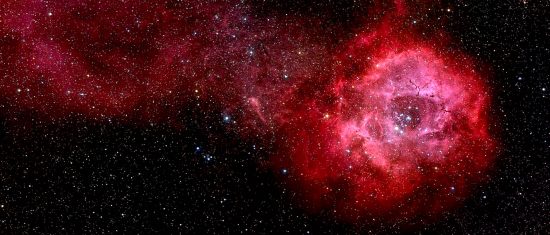
The Rosette Nebula, approximately 5,000 light-years from Earth. The nebula is a cloud of dust, hydrogen, helium and other ionized gases, with several massive stars at its heart. Credit: Nick Wright, Keele University. Click to enlarge.
Mar 2, 2018
The Rosette Nebula reveals its plasma structure.
“I turn my eyes to the schools & universities of Europe
And there behold the loom of Locke whose woof rages dire
Washed by the water-wheels of Newton. black the cloth
In heavy wreaths folds over every nation; cruel Works
Of many Wheels I view, wheel without wheel, with cogs tyrannic
Moving by compulsion each other: not as those in Eden: which
Wheel within Wheel in freedom revolve in harmony and peace.”
— William Blake
Every science journal insists that nebulae are formed by “blowing winds” from exploding stars. They are often described as “star factories”, because when X-rays from nebulae are detected, they are said to be generated by fusion reactions in new stars.
Recently, astronomers from the University of Leeds reported that their computer simulations of the Rosette Nebula best describe its formation when a thin disk of dust and gas is plugged-in to their models, instead of a thick disk, or a spherical cloud. The simulation was created because “… the cavity observed in the centre of Rosette Nebula is too small when compared to the age of its central stars — something that has has puzzled astronomers for decades.”
The prevailing opinion is that nebulae form “knots” when “winds” from exploding stars “crash” into them. The winds are said to cause low density clouds to coalesce, eventually giving birth to stars through hydrogen fusion. Problems with the standard model of stellar evolution are not the topic of this paper. Suffice to say, Electric Universe theory sees plasma, not inert gas and dust, flowing through space. The physics of electricity applies, not the physics of wind. Planetary nebulae exhibit one or more plasma sheaths, or double layers, that alternately increase and decrease electric charge flow within them.
Electric discharges in plasma clouds create double layers. Positive charge builds up on one side of a double layer and negative charge on the other. An electric field develops between the sides, and if enough current is applied the double layer will glow, otherwise, it is described as “dark mode” and can only be seen in frequencies other than visible light.
As previously written, a neon lamp would model nebulae more correctly. Electricity passing through neon gas causes it to form a plasma that glows pale yellow. Other gases, such as oxygen or hydrogen, produce blue and red light, while heavier elements emit their own colors. The Rosette Nebula exhibits emissions at all of those wavelengths.
Astronomers, who think in absolute terms of gravity and mass, seldom think about electric charge. They think of charged particles moving along a magnetic field as a “jet”, instead of a field-aligned Birkeland current. They think of abrupt changes in the density and speed of charged particles as a “shock wave”, instead of a double layer that can explode.
Plasma’s behavior is driven by fluctuations in electric charge flow; meaning that electric forces in double layers are several orders of magnitude stronger than gravity. Double layers separate plasma into cells and filaments that can have different temperatures or densities. In the case of the Rosette Nebula, the image is a view “down the barrel” of a Bennett pinch structure formed by a pair of Birkeland current filaments. The Bennett pinch regions are seen end-on, where electricity flowing into them causes plasmas to radiate in a glow mode discharge.
Since charged particles in motion constitute an electric current, a magnetic field wraps around the current channel, diminishing with distance. That magnetic field gets stronger when more charged particles move in the same direction or when they move faster. Ions moving through the magnetic field are squeezed toward the axis. This is the Bennett pinch referred to, above.
As pointed-out in the past, 90% of the light from nebulae comes from ionized oxygen. Electric forces acting on stars might offset their internal positive charges. If that happens, the positive charges will repel each other and accelerate away from the centers of the stars, resulting in an expulsion disk composed of ionized gases and dust. Expulsion disks are most likely what forms nebular barrels, like the Rosette Nebula.
When electric charge flow is low and nebular plasmas contain small concentrations of dust, only the stars “light up” in arc-mode discharge. Where electrical stress is greater, curling filaments, jets, and the surrounding gas clouds also light up. Dust and gas can reflect the light from nearby stars, but the Rosette Nebula reveals characteristic filaments seen in laboratory plasma experiments.
Does charge separation take place in nebulae? It will, most likely, take centuries to answer that question, since the only way to detect a double layer in space is by flying a Langmuir probe through one. However, double layers abound everywhere in the Solar System: the Sun’s heliosphere, comet tails, and magnetospheres are all examples of charge separation in plasma.
An Electric Universe assumes that plasma behaves in the same way whether in the laboratory, or in a formation like the Rosette Nebula. Double layers, resulting from charge separation in space, prompted Nobel laureate Hannes Alfvén to suggest that they be considered their own class of celestial object. If that were so, astronomers would find important clues to the mysteries that confound them.
Stephen Smith












